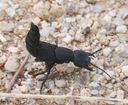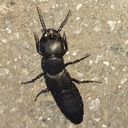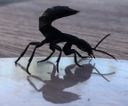Devil's Coach Horse
Ocypus olens
Classification
- Phylum: Arthropoda
- Subphylum: Hexapoda
- Class: Insecta
- Order: Coleoptera
- Suborder: Polyphaga
- Superfamily: Staphylinoidea
- Family: Staphylinidae
- Subfamily: Staphylininae
- Tribe: Staphylinini
- Subtribe: Staphylinina
- Genus: Ocypus
- Species: olens
Pronunciation
How to pronounce Ocypus olens: /ˈo.sɪ.pus ˈoː.lɛns/
These audio files are automatically generated. While they are not always 100% accurate, they are a good starting point.
Images






Summary
Ocypus olens, commonly known as the Devil's Coach Horse, is a predatory rove beetle known for its distinctive long body and defensive behavior. It is found in various habitats across Europe and North America, contributes to pest control, and holds various cultural significances.
Physical Characteristics
Long-bodied, black beetle approximately 25-28 mm in length. Wing covers (elytra) are short, exposing the abdominal segments. The abdomen is long and uncovers, with powerful musculature covered in fine black hairs. Emitting a foul-smelling odour from white glands at the end of its abdomen as a defense mechanism.
Identification Tips
Notable for its habit of raising its long, uncovered abdomen and opening its jaws when threatened. It has strong, pincer-like jaws capable of a painful bite.
Habitat
Prefers damp conditions found in meadows, heath and moorland, woodlands, hedgerows, parks, and gardens.
Distribution
Native to Western Palaearctic, introduced to parts of North America including Washington, California, Arizona, and parts of British Columbia.
Diet
Predator feeding mainly on invertebrates including worms, slugs, spiders, small moths, and woodlice, as well as carrion. Larvae have similar carnivorous feeding habits.
Life Cycle
Eggs are laid after a 2-3 week mating period. Larvae undergo three stages of growth before pupating for about 35 days after emerging as an adult.
Reproduction
Mating occurs in autumn, with females laying eggs 2-3 weeks after. Eggs are laid singly in damp conditions; larvae emerge approximately 30 days later and live largely underground.
Ecosystem Role
Predatory species contributing to the control of invertebrate populations.
Economic Impact
May help control introduced pest species such as the brown garden snail.
Cultural Significance
Associated with devil folklore, referred to as 'the coffin cutter' in Irish culture. Crushing the beetle is said to forgive seven sins according to British folklore.
Health Concerns
Emits a foul odour for defense but is not harmful to humans. Can inflict a painful bite if handled.
Collecting Methods
- Hand collecting under logs or stones
- Malaise traps in suitable habitats
Preservation Methods
- Drying specimens
- Mounting on pins
Evolution
Initially classified under the genus Staphylinus until separated into the genus Ocypus.
Similar Taxa
- Staphylinus spp.
- Other Staphylinidae species
Misconceptions
Despite its name and appearance, it is not a true scorpion and does not possess a sting.
Tags
- beetle
- predatory species
- folklore
- invertebrate
- Palaearctic
- North America